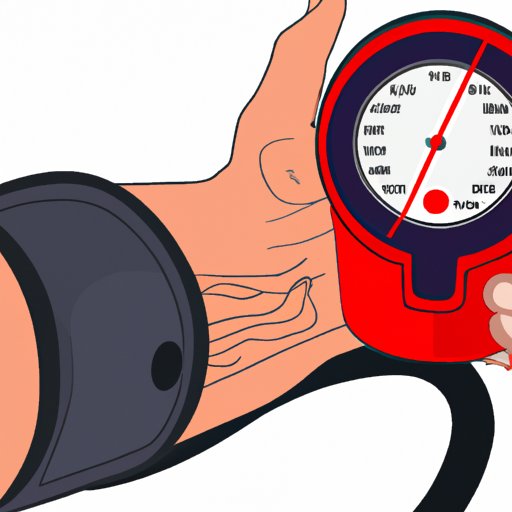Introduction
Blood pressure is a measure of the force exerted against the walls of the arteries as blood is pumped through the body. It is usually measured as two numbers: systolic (the top number) and diastolic (the bottom number). High blood pressure (also known as hypertension) is a condition where the pressure of the blood against the artery walls is consistently too high. It is a major risk factor for cardiovascular disease, stroke, and other serious conditions.
The relationship between exercise and blood pressure is complex. On one hand, regular physical activity can help reduce high blood pressure and improve overall health. On the other hand, certain types of exercise can cause a temporary spike in blood pressure.
Exploring the Link Between Exercise and Blood Pressure
Exercise can have both positive and negative effects on blood pressure. Depending on the type of exercise and other factors, it can either raise or lower blood pressure. In general, aerobic activities like walking, running, and cycling tend to lower blood pressure while strength training and other more intense exercises can cause a temporary rise in blood pressure.
There are several factors that can influence how exercise affects blood pressure. These include age, gender, fitness level, and the intensity of the activity. For example, younger people typically experience greater decreases in blood pressure than older individuals during moderate-intensity aerobic activity. Furthermore, men often experience greater reductions in blood pressure than women.
Is it Safe to Exercise with High Blood Pressure?
Regular exercise is recommended for people with high blood pressure, as it can help reduce blood pressure over time. However, it is important to take certain precautions when exercising with hypertension. People with high blood pressure should consult their doctor before starting any new exercise program, as some activities may be too strenuous for their condition.
The benefits of regular exercise for blood pressure control include improved heart health, increased circulation, and better stress management. Regular physical activity can also help reduce weight and cholesterol levels, both of which are important for controlling hypertension. However, there are risks associated with exercising with high blood pressure, such as dizziness, fainting, or chest pain.

Exercising to Lower Blood Pressure
Any type of physical activity can help lower blood pressure. However, some types of exercise are more effective than others. Aerobic activities like walking, jogging, swimming, biking, and dancing are particularly beneficial for reducing blood pressure. Strength training can also help lower blood pressure, but it should be done in moderation. Additionally, yoga, tai chi, and other forms of relaxation exercises can help lower blood pressure.
It is important to understand how exercise affects blood pressure. For most people, blood pressure will decrease as they become more physically active. However, for some people, blood pressure can rise during exercise due to the extra strain placed on the heart. This is why it is important to monitor your blood pressure before, during, and after exercise.

Tips for Managing Blood Pressure During Exercise
When exercising with high blood pressure, it is important to take certain precautions to ensure safety. Here are some tips for managing blood pressure during exercise:
- Monitor your blood pressure before, during, and after exercise. This will help you track your progress and adjust your activity level as needed.
- Stay hydrated. Dehydration can lead to an increase in blood pressure, so it is important to drink plenty of fluids before, during, and after exercise.
- Eat a balanced diet. Eating a healthy diet full of fruits, vegetables, whole grains, and lean proteins can help keep your blood pressure in check.
- Take breaks when needed. If you feel lightheaded, dizzy, or short of breath during exercise, take a break and rest until you feel better.
Conclusion
Exercise is an important part of overall health and wellbeing, but it can also cause changes in blood pressure. The relationship between exercise and blood pressure is complex, and different types of physical activity can have varying effects. Regular exercise can help lower blood pressure over time, but it is important to take precautions when exercising with hypertension. Monitoring your blood pressure before, during, and after exercise, staying hydrated, eating a balanced diet, and taking breaks when needed can help ensure your safety when exercising with high blood pressure.


